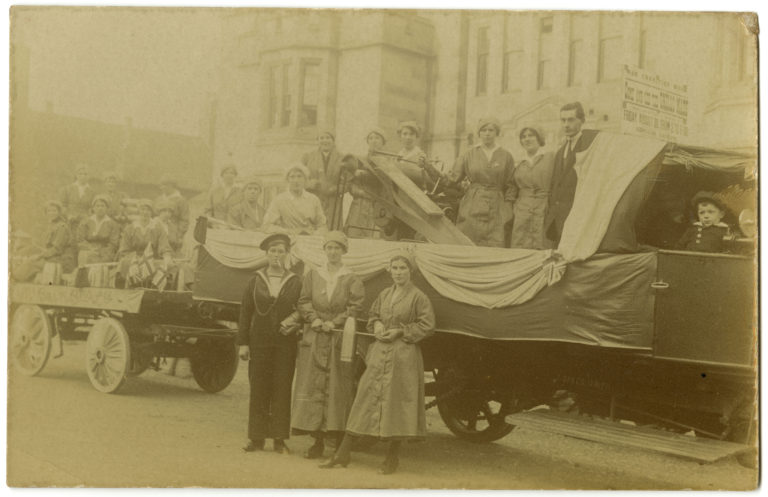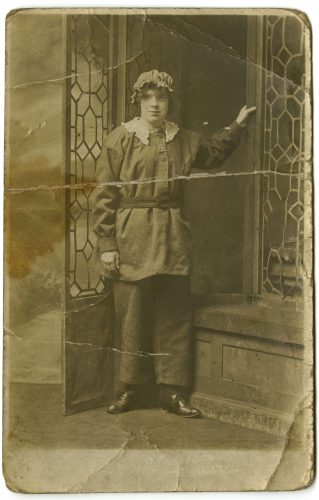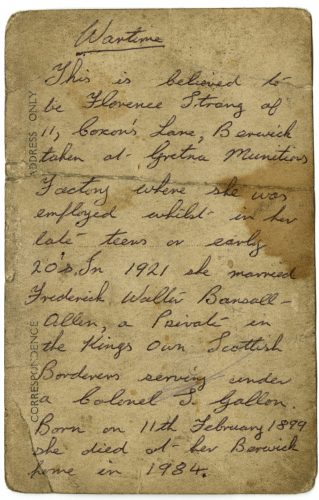Photographs of women munition workers, about 1915-19
Reference: BRO 02179/10, BRO 02190/1, NRO 10146/25
Suggested age groups: KS1, KS2, KS3, KS4, Lifelong Learners
Subject areas: History, Literacy, Biology, Art
CONTEXT
At the start of the war, the government relied on volunteers for the army. By 1915 it was obvious that not enough men had been recruited, so the government introduced compulsory conscription. In 1916 men over 18 and under 41 years of age had to join the armed services.
Production of munitions also increased in 1915 due to the Shell Crisis (a shell is like a very large explosive bullet). The national newspapers claimed that the deadlock on the Western Front resulted from a lack of shells and that the shells that got to the Front were not of good enough quality. The newly formed Ministry of Munitions built new factories, like the one at Gretna, in response.
The increased demand for munitions and the number of men available to fill these engineering jobs decreased. This meant that munitions factories needed to employ women in large numbers. Women working in factories was not new, they had worked in cotton mills since the industrial revolution, but engineering was still seen as a job for men.
The work was often dangerous, and women died from accidental explosions and from being poisoned by the chemicals that they handled. The names of some of these women appear on the Five Sisters War Memorial in York Minster (see online resources).
The women in the posed group photograph (NRO 10146/25) are all wearing the uniform of munitions workers. Their caps kept their hair out of the machinery. Most of them are wearing a triangular badge that shows that they were doing war work (see online resources).
The sign on the float in the photograph of Berwick War Charities’ procession (BRO 02179/10) shows that these women were munitions workers. They charged 6 pence towards the war charities for a demonstration of the work that they were doing. The other Berwick photograph (BRO 02190/1) shows Florence Strang who worked at the Gretna Munitions Factory.
ACTIVITIES
ACTIVITY 1
Background
Production of munitions increased in 1915 due to the Shell Crisis. The national newspapers claimed that the deadlock on the Western Front resulted from a lack of shells and that the shells that got to the Front were not of good enough quality. The newly formed Ministry of Munitions built new factories, like the one at Gretna, in response.
The increased demand for munitions and the number of men available to fill these engineering jobs decreased. This meant that munitions factories needed to employ women in large numbers. Women working in factories was not new, they had worked in cotton mills since the industrial revolution, but engineering was still seen as a job for men. The work was often dangerous, and women died from accidental explosions and from being poisoned by the chemicals that they handled.
SEE
See: What was the Shell Crisis?
See: What did the Ministry of Munitions build?
See: Why did munitions factories need to hire large numbers of women?
See: How safe were munitions factories to work in?
THINK
Think: Why did the Shell Crisis happen?
Think: Why did women wear a triangular badge to show they were doing war work?
Think: What types of war work did women do?
Think: Did women get to keep their jobs after the war ended?
Think: Were women paid the same as men during WW1?
DO
Do: Imagine you are a medical officer who has been asked to write a report on the types of injuries and their causes that munitions workers suffered from. Use the testimonies from the Imperial War Museum Voices of the First World War and Dangers of Working in a First World War Munitions Factory pages to help you.
Do: Watch the film ‘A Day in the Life of a Munitions Worker’. Write a diary entry as though you are one of the women describing their day and they work they have done.
Do: Read and listen to the testimonies on the ‘Threat of Explosions’ section from the Imperial War Museum webpage about the Dangers of Working in a First World War Munitions Factory. Write a poem inspired by those who experienced the explosions. Think about the sensory experience as well as what they might have felt.
Do: Look at the photograph of the women wearing the uniform of munitions workers. How safe do you think these uniforms were for this type of work. Draw a diagram of the uniform and label it showing where the uniform protects the wearer; hazards the outfit could cause; and make suggestions for a more protective outfit.
Do: Imagine you are a female war worker. Write a speech stating why you should be paid equally to what men are paid for working the same role. Use facts to back up your point.
Do: Look at the Imperial War Museum’s webpage for the Tweedmouth War Memorial. Can you find the name of a female munitions worker?
Do: Imagine you a relative of Ellen Ainslie, the female munitions worker listed on the Tweedmouth War Memorial, who died because of her work at the Gretna Munitions Factory. Write a speech justifying why Ellen’s name should be included on the war memorial.
Do: Visit your local War Memorial. Can you find the names of any female war workers?
Do: Design a war memorial for all of the female war workers who lost their lives during WW1.
Resources
https://www.iwm.org.uk/history/voices-ofthe-first-world-war-munitions
https://www.iwm.org.uk/history/a-day-inthe-life-of-a-munitions-worker
https://www.iwm.org.uk/history/9-womenreveal-the-dangers-of-working-in-a-firstworld-war-munitions-factory
https://www.bbc.co.uk/bitesize/guides/zspnn39/revision/2
https://www.bbc.co.uk/bitesize/topics/zqhyb9q/articles/zj8my9q
http://www.bbc.co.uk/history/british/britain_wwone/women_employment_01.shtml
https://www.strikingwomen.org/module/women-andwork/world-war-i-1914-1918
https://yorkminster.org/discover/stories/story/the-sisters-window-for-the-sisters/
OTHER ONLINE RESOURCES
The National Archives blog, page about campaigns for equal pay for female munition workers in WWI: https://blog.nationalarchives.gov.uk/equal-pay-equal-work-female-munitions-workers/
Women’s Engineering Society website, page about history of the society (founded 1919): https://www.wes.org.uk/content/history
BBC Bitesize website, page about 1915 Shell Scandal: https://www.bbc.co.uk/bitesize/guides/zspnn39/revision/2
BBC Bitesize website, page about women’s war work (including animation and photographs of different types of work): https://www.bbc.co.uk/bitesize/topics/zqhyb9q/articles/zj8my9q
BBC Bitesize website, page about political impact of women’s war work after the war: https://www.bbc.co.uk/bitesize/guides/zx9887h/revision/4
Gretna Munitions Factory
Gretna Munitions Factory Museum website: https://www.devilsporridge.org.uk/about
Imperial War Museum, including oral histories
Imperial War Museum “Voices of the First World War” podcasts, munition workers: https://www.iwm.org.uk/history/voices-of-the-first-world-war-munitions
Imperial War Museum “Voices of the First World War” podcasts, women in the auxiliary services: https://www.iwm.org.uk/history/voices-of-the-first-world-war-womens-war-services
Imperial War Museum website, page about war service badges: https://www.iwm.org.uk/history/on-war-service-badge
Imperial War Museum website, page about women’s war work: https://www.iwm.org.uk/history/12-things-you-didnt-know-about-women-in-the-first-world-war
Five Sisters War Memorial, York Minster
York Clio website for history teachers, page with classroom activities related to Five Sisters War Memorial: https://yorkclio.com/tag/york-minster/
York Minster website, page about the Five Sisters War Memorial: https://yorkminster.org/discover/stories/story/the-sisters-window-for-the-sisters/
Women Engineer history blog site, page about the Five Sisters War Memorial: https://womenengineerssite.wordpress.com/2018/11/09/remembering-women-who-worked-and-died-for-their-country-munition-workers-of-ww1-canary-girls-and-others/





